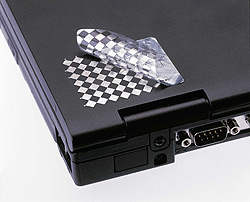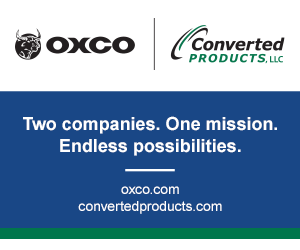Special Report: Pressure-Sensitive Labels-Locked & Loaded
- Published: July 01, 2010, By By Dr. William Llewellyn, AWA Alexander Watson Assoc.

With 7%-8% of world trade now in counterfeit goods, product manufacturers face a real battle to ensure that what they deliver via the retailer to the consumer is their genuine branded product, not tampered with, and not a harmful counterfeit. Understandably, they are taking every possible step to protect their products, not just through monitoring the manufacturing and distribution chain but at item level.
This is particularly true on labels and packaging. They have proved to be the ideal carrier for all kinds of security messaging — both visible to the naked eye and, more importantly, visible only via special scanners.
Converters: The Enablers
It is the converting industry that ultimately delivers the functional side of the anti-counterfeiting equation. This is an area that offers real opportunities for developing profitable converter business today.
Product manufacturers with a valuable brand name to protect often choose to use a combination of overt (visible) and covert (invisible) security solutions. These are layered into a label or packaging to make it as difficult as possible for counterfeiters to replicate the full portfolio of security features and pass off fake goods as the real thing.
In an ideal world, converters will provide their customers with a unique solution for each different label or package. Particularly in high-value applications, the combination of security devices will be changed at frequent intervals.
A Partnership
Converters involved in the production of packaging and/or labels are perceived as partners in brand protection. Often they are required to be signatories to confidentiality agreements.
Whether or not they are specialists in security labeling, printers in such partnerships are expected to contribute innovation to the ever-changing raft of security features. This can involve the purchase of licenses for using proprietary security imaging technologies.
Why Pressure-Sensitive?
The p-s label has proved to be one of the prime technical solutions for delivering high quality brand protection messaging via print, but it also offers the added option of engineering brand security devices into its construction. Laminate manufacturers offer a broad platform of options for engineered security label stocks.
Today's modular and platform narrow web presses make possible extremely complex multiple print solutions using different print processes. These include digital print, of course, which can deliver the extra dimension of sequential numbering as well as article-specific identification such as a bar code.
Converters can add specific overt and covert features to their printed labels. Security inks for converting by the traditional print processes vary from thermochromic and chemichromatic to magnetic, holographic, ultraviolet (UV)/infrared (IR) fluorescent, coin reactive, erasable, and bleach indicators.
Inks that carry micro-taggants and inks that reveal their iridescence only when a fraudster tries to photocopy them — invisible to the naked eye without a special reader — also are available, as are specific security solutions for digital inkjet processes and thermal transfer ribbons. Stamping foils also can contribute, with invisible UV fluorescent qualities, diffraction foils, two- and three-dimensional or dot matrix holograms, and magnetic foils.
The First-Level Devices
Consumers are very familiar with the overt security devices on labels, and they are a first-line choice as a means of reassurance of brand authenticity and purity. Over-the-cap p-s paper seals on jars and bottles, made from papers that tear easily, provide ready evidence of prior opening and possible tampering. Optically variable devices (OVDs) in the form of holograms are popular and well-recognized.
Other first-level devices include “hidden word” p-s label constructions. Applied, for example, as a pack seal, they look like perfectly ordinary labels, but when lifted to open the pack, they leave behind a visible message — the word “void” is standard in the industry, but they can be personalized. This provides strong visual evidence that the packaging has experienced tampering.
Invisible Protection
It is in the invisible spectrum of product authentication devices, however, that the highest levels of security are achieved. Here, p-s labels offer outstanding versatility. Because of their multilayer construction, they present several different surfaces to which a security device can be applied.
Next Page: Track & Trace
As already discussed, this can be achieved via ink and other depositions on the label's surface, but it also can be applied to the label substrate's underside or even embedded in the face-stock. It can be mixed into the label adhesive or coated above or below it.
In the label face material (paper or film), a catalog of covert options might include two- or three-dimensional, customer-exclusive watermarks; nylon fibers of a specific length or color, readable only in UV or IR light; and metal strips or fragments (invisible to the naked eye) embedded in the facestock. Polyester security threads, thermochromic threads, and micro-marked fibers are other possibilities.
Solvent-sensitive papers, developed to prevent information being removed with the use of solvent, also are available. Iridescent security color stripes — impossible to reproduce by photocopier, offset print, or computer printers — can be applied to paper facestocks.
Near-IR fluorophores, chemical taggants, or microtaggants (including DNA) can be built into the label construction and are detectable only with dedicated scanners. There is even a tagging system that is invisible to forensic trace methods.
Track & Trace
Track-and-trace technologies, such as RFID, are another pathway that offers a powerful platform of protection for products as they move through the supply chain — and the p-s label is still the central enabler in RFID packaging applications. It goes without saying that multilayer security labeling solutions should be at least customer-unique, if not label-unique.
Package printers interested in expanding their product offering into the realms of security print as a speciality — or who are interested in supporting their existing client base with the extra dimension of security print — certainly can draw on plenty of options. A good starting point would be the selection of a portfolio of overt and covert technologies that could be maintained in-house for “mix and match” use.
From these, a unique solution to meet the manufacturer's deliverables usually can be constructed, its complexity limited only by the seriousness of the security threat to the product, its vulnerability, and the funds available. For highly complex solutions, formal supply chain partnerships may be necessary, involving — in addition to the converter — raw material suppliers, p-s laminators, ink manufacturers, and press manufacturers.
As yet there are no international standards for producers of security labels and no global register of security label printers, so converters wishing to explore the possibilities of such partnerships may wish to draw on the experience and expert knowledge of members of such organizations as the International AntiCounterfeiting Coalition, the Brand Protection Alliance, and the Brand Protection Council for advice on available technologies and practical implementation. Market-specific organizations with a particular focus on anti-counterfeiting, such as the International Assn. of Pharmaceutical Mfrs., also can deliver valuable insights into important features such as distribution channels.
Dr. William Llewellyn is VP and senior consultant with AWA Alexander Watson Assoc., Amsterdam, Netherlands, a market research firm specializing in packaging and converting. Contact him at +31 20 676 20 60; www.awa-bv.com.
Want To Learn More?
Be sure to visit www.pffc-online.com to find more Special Reports, an RFID One-Stop content category, and additional brand security coverage.
AWA Conferences & Events organizes PABS10, the product authentication and brand security conference, taking place in Chicago, October 4-5. For further information and online registration, visit www.awa-bv.com.












